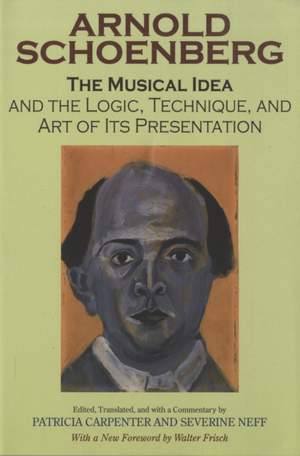The Musical Idea and the Logic, Technique, and Art of Its Presentation, New Paperback English Edition
- Author: Schoenberg
- Translator: Carpenter, Patricia
- Translator: Neff, Severine
[this book] is the single best volume extant if one wishes to learn about the technical conception of music held by one of the greatest composers (and greatest music educators) of modern times — More…
Book
$33.75Contents
- Contents
- Foreword (2006) by Walter Frisch
- List of Abbreviations of Cited Sources
- Editors' Preface
- Acknowledgments
- Commentary
- Schoenberg's View of Art
- Schoenberg's Preface
- The Musical Idea
- Comprehensibility and Coherence
- Theory of Form
- The Constructive Function of Harmony
- Conclusion
- The Musical Idea and the Logic, Technique, and Art of Its Presentation
- Preface and Overview
- Preface
- Title Page
- Principles of the Presentation of the Idea
- Plan of the Book
- The Profundity of the Idea and Its Realization as a Standard
- The Musical Idea and the Logic, Technique, and Art of Its Presentation
- Idea (1 and 2)
- The Idea in the Contrapuntal Art of Composition and Its Presentation
- Principles of Construction
- Comprehensibility
- Laws of Comprehensibility
- Coherence
- The Laws of Musical Coherence
- Elements of Form
- The Parts of a Piece
- Part Elements of Form
- Phrase
- Gestalt
- Grundgestalt and Motive
- The Difference Between Gestalt and Phrase
- Features of the Motive
- Statement
- Stable Formation
- Loose Formation
- Theme
- Melody
- Sonority as a Formative Element
- Rhythm
- Rhythm
- Classification of Rhythms
- Accentuation and Nonaccentuation
- Formal Procedures
- [Formal Procedures]
- Articulation
- Change, Variation, Variant, Varying
- Kinds of Variation
- Coherence of "New Components"
- Mirror Forms
- Close
- Cadencing
- Cadential Fall
- Kinds of Connection
- Technique of Joining
- Condensation
- Dissolution, Liquidation
- Tendency of the Smallest Notes
- The Structural Capacities of the Scale
- Wave-Shaped Progression
- Contrasts (Contrasting Themes)
- Digression from the Main Idea
- Principal Idea, Subsidiary Idea
- Subordinate Theme
- Secondary, Tertiary, etc. Gestalten and Motives
- The Shaping of Principal and Subordinate (Accompanying) Voices
- Development Section
- Sequences
- Intensification
- Does Repetition Have an Intensifying Effect?
- Voice (Independent)
- Introduction (1 and 2)
- Preparation
- Extramusical Means of Coherence
- Fantasy
- Description of All Forms
- Miscellaneous
- Performance and Gestalt
- The Sense of Rit. and Accel.
- Relaxation
- Symmetry
- Origin of Repetitions
- Primitive Principles
- Popular Music and Melody
- Harmony
- The Constructive Function of Harmony
- Addendum
- Keywords Still to Be Indexed
- Keywords
- Concordance of Terms
- Appendix 1 Descriptions of the Gedanke Manuscripts
- Appendix 2 Contents of Manuscript No. 10, Listed in Their Original Order
- Appendix 3 German Texts of Unpublished Gedanke Manuscripts Referred to in the Commentary
- Notes
- Bibliography
- Index of Musical Examples
- Name Index
- Subject Index



